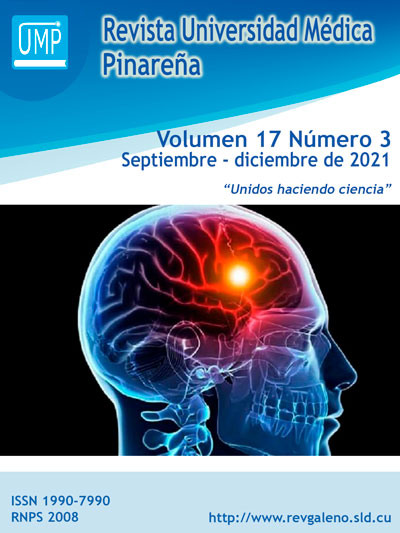Characterization of patients with intraparenchymal hemorrhagic cerebrovascular disease treated at the National Institute of Neurology and Neurosurgery
Keywords:
Hemorrhagic Stroke, Cerebral Hemorrhage, Intracranial Hemorrhages, Cerebrovascular Disorders.Abstract
Introduction: intracerebral hemorrhage represents 10 to 15% of all strokes, and depending on its location, it can be intraparenchymal or intraventricular.
Objective: to characterize patients diagnosed with intraparenchymal hemorrhagic cerebrovascular disease at the National Institute of Neurology and Neurosurgery.
Method: an observational, descriptive and cross-sectional study was carried out in patients diagnosed with intraparenchymal hemorrhagic cerebrovascular disease at the National Institute of Neurology and Neurosurgery of Cuba between January 2017 and December 2019. The variables age, sex, skin color, toxic habits, personal pathological history, status at admission, extension to ventricle, location, affected cerebral hemisphere and associated cerebral edema. Descriptive statistics were used.
Results: patients in adulthood (53,5 %), male (64,2 %) and white skin color (85,7 %) predominated; as well as smoking (28,5 %). A higher frequency was observed in patients with hypertension (50 %) and in a conscious state upon admission (82,1 %). 60,7 % did not have ventricular extension. Thalamic intraparenchymal hemorrhages were the most frequent (21,4 %). The most affected cerebral hemisphere was the right (60,7 %). A greater number of patients with associated cerebral edema was observed (85,7 %).
Conclusions: hemorrhage occurred more frequently in adult, male and white-skinned patients. The personal history of arterial hypertension was found in most of the cases; showing a predominance of presentations in right structures and associated cerebral edema.
Downloads
References
2. Sieira PI, Esparragosa I, Valentí R, Martínez-Vila E. Enfermedades cerebrovasculares. Hemorragia cerebral. Medicine-Programa de Formación Médica Continuada Acreditado [Internet]. 2019 [citado 23/11/2020]; 12(70):4075-4084. Disponible en: https://www.sciencedirect.com/science/article/pii/S0304541219300010
3. López Arguelles J, Rodríguez Carbajal AB, Sosa Águila LM, Rojas Fuentes J. Factores relacionados con la mortalidad y las discapacidades en la hemorragia cerebral parenquimatosa espontánea. Rev Cubana Neurol Neurocir [Internet]. 2015 [citado 23/11/2020]; 5(1):19-24. Disponible en: http://www.revneuro.sld.cu/index.php/neu/article/download/153/271
4. Hernández-Ortiz OH, Torres-López M, Sará-Ochoa JE. Manejo intensivo vs. conservador de la presión arterial en pacientes con hemorragia intracerebral aguda: revisión sistemática y metaanálisis. Acta Colom. Cuidado Intensivo [Internet]. 2018 [citado 23/11/2020]; 18(1):1-9. Disponible en: https://www.elsevier.es/es-revista-acta-colombiana-cuidado-intensivo-101-articulo-manejo-intensivo-vs-conservador-presion-S012272621730071X#
5. Méndez Fleitas L, Carmona Denis Y, Moreno Peña LE, Escalona Robaina CR, Ortega Peñate JA. Caracterización clínica de la hemorragia intracerebral en pacientes ingresados en Hospital Faustino Pérez 2012-2013. Rev Med Electrón [Internet]. 2019 [citado 23/11/2020]; 41(1):90-103. Disponible en: http://scielo.sld.cu/scielo.php?pid=S168418242019000100090&script=sci_arttext&tlng=en
6. Suárez Quesada A, Álvarez Aliaga A, López Espinosa E, Barzaga Morell S, Santisteban García AL. Pronóstico de muerte en pacientes con hemorragia intracerebral supratentorial espontánea. Rev Finlay [Internet]. 2016 [citado 23/11/2020]; 6(1):12-14. Disponible en: http://scielo.sld.cu/scielo.php?script=sci_arttext&pid=S2221-24342016000100005
7. Morales CD, Aguirre C, Machado JE. Factores predictores para accidente cerebrovascular en el Hospital Universitario San Jorge Pereira (Colombia). Rev Científica Salud Uninorte. [Internet] 2016 [citado 23/11/2020]; 1(32):e34. Disponible en: http://www.scielo.org.co/pdf/sun/v32n1/v32n1a05.pdf
8. Racca FR. Validación del modelo matemático predictivo de mortalidad para la hemorragia supratentorial espontánea. Salud(i) Ciencia [Internet]. 2015 [citado 23/11/2020]; 25(2015):598-603 Disponible en: http://www.siicsalud.com/dato/sic/216/148592.pdf
9. Higgie J, Urban L, Johen Hackembruch H, Gaye A. Análisis de una Cohorte de Pacientes con ACV del Joven. Hospital de Clínicas, Montevideo. Rev urug med interna [Internet]. 2018 [citado 23/11/2020]; 3(2):3-12. Disponible en: http://www.scielo.edu.uy/pdf/rumi/v3n2/2993-7697-rumi-3-02-3.pdf
10. Del Brutto OH, Del Brutto VJ, Zambrano M., Lama J. Enfermedad Cerebrovascular en Atahualpa: Prevalencia e Incidencia. Rev Ecuatoriana Neurología [Internet]. 2017 [citado 23/11/2020]; 26(2):3-6. Disponible en: http://scielo.senescyt.gob.ec/pdf/rneuro/v26n2/2631-2581-rneuro-26-02-00158.pdf
11. Goldman L, Schafer AI. Goldman-Cecil. Tratado de Medicina Interna [Internet]. 25. a ed. Madrid, España: Elsevier; 2017 [citado 23/11/2020]. Disponible en: https://inspectioncopy.elsevier.com/6/es/book/details /9788491130338
12. Vergara A, Rodríguez J, Barrós P. Hemorragia intracerebral espontánea: características tomográficas y evolución. Rev Finlay [Internet]. 2015 [citado 23/11/2020];5(4):2-4. Disponible en: http://scielo.sld.cu/scielo.php?script=sci_arttext&pid=S222124342015000400005
13. Kumal E, Ece Bayam F, Koken B, Emre Erdogan C. Clinical and neuroimaging determinants of minimally conscious and persisten vegetative states after acute stroke. J Neurocrit Care [Internet]. 2019 [citado 23/11/2020]; 12(1):37-45. Disponible en: https://www.e-jnc.org/m/journal/view.php?doi=10.18700/jnc.190080
14. Sosa Remon A, Jerez Alvarez AE, Garcia Arias DM, Cuba Naranjo AJ, Galiano Guerra G. Factores neurológicos asociados a la mortalidad en pacientes con accidente cerebrovascular y ventilación mecánica artificial. Rev Cuba Anestesiol Reanim [Internet]. 2020 [citado 23/11/2020]; 20(2):e688. Disponible en: http://www.revanestesia.sld.cu/index.php/anestRean /article/viewFile/688/983
15. Carrillo Esper R, Rangel-Olascoaga CR. Hemorragia talámica. Médica Sur. [Internet] 2018 [citado 23/11/2020]; 20(2):117-123. Disponible en: https://www.medicasur.com.mx/pdf-revista/RMS132-CC02-PROTEGIDO.pdf
16. Mieles DB, Carlier FB, Alvarado GH, Mata FS. Hemorragia Talámica Bilateral. Bilateral Thalamic Hemorrhage. Rev Ecuat Neurol [Internet]. 2017 [citado 23/11/2020]; 26(1)¬:11-12. Disponible en: http://revecuatneurol.com/wpcontent/uploads/2017/09/Hemorragia-Talamica-Bilateral.-BilateralThalamic-Hemorrhage.pdf
17. Arboix A. Hemorragias cerebrales pontinas: estudio de 14 pacientes. Medicina Clínica [Internet]. 2008 [citado 23/11/2020]; 130(9):339-341. Disponible en: https://doi.org/10.1157/13117356
18. Lemus Fajardo NM, Linares Casanovas LP, Lazo Herrera LA, Linares Casanovas LB. Caracterización de adultos mayores con ictus. Acta Médica del Centro [Internet]. 2019 [citado 23/11/2020]; 13(3):3-11. Disponible en: https://www.medigraphic.com/pdfs/medicadelcentro/mec-2019/mec193c.pdf
19. Salas Martínez NM, Lam Mosquera IE, Sornoza Moreira KM, Cifuentes Casquete KK. Evento Cerebro Vascular Isquémico vs Hemorrágico. RECIMUNDO [Internet]. 2019 [citado 23/11/2020]; 3(4):177-193. Disponible en: https://www.recimundo.com/index.php/es/article/download/658/862
20. Araujo Montes RE. Frecuencia de accidente cerebrovascular hemorrágico por tomografía computarizada multidetector en pacientes con stroke cerebral en el hospital Sergio E. Bernales 2018. [Tesis de Licenciatura]. Lima: Universidad Médica de Perú. Internet 2018 [citado 23/11/2020]. Disponible en: https://repositorio.upla.edu.pe/bitstream/handle/20.500.12848/1114/TESIS%20FINAL.pdf?sequence=1







